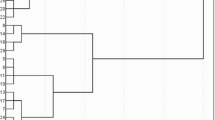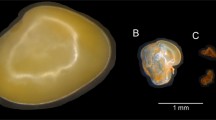Summary
The effect of selection for two-seeded pods in diploid and tetraploid populations and the effect of chromosome doubling on two-seededness were studied. The material obtained was examined to find out how important two-seeded pods are for seed set, grain weight and seed yield.
In a mixoploid plant the percentage two-seeded pods in the tetraploid heads was far smaller than that in the diploid heads. Only when the character had developed relatively strongly in the diploid, did it exceed a very low value.
By selection of individual plants in the best families of a diploid group of plants the percentage two-seeded pods could be raised from on average 7.4 to 30.6% as early as the following generation. Similar selection in tetraploid material with 2.5% two-seeded pods did not increase the percentage.
The reduction of grain weight of seed in two-seeded pods compared with that in one-seeded pods was greater in the tetraploid plants than in the diploids.
No effect of two-seededness on seed yield was found in our material. A marked effect on seed-set was observed in a diploid population (286 plants) when the percentages two-seeded pods rose about 16%.
As the correlation between the calculated number of heads and the seed yield per plant is high, it may be adopted that in our material the number of heads per plant was decisive of seed yield. This will contribute to the small effect of two-seededness on the seed yield of the plant.
The results of the present study showed that the production of tetraploids with a high percentage two-seeded pods will take more advantage of selection of diploid material followed by doubling of chromosomes than of direct selection in the tetraploids.
Protrusion of pods in heads indicates a very high percentage two-seeded pods. This will enable relatively rapid selection for two-seeded pods.
A quite small percentage two-seeded pods also occurred in two tetraploid populations that had not been selected for two-seeded pods.
Similar content being viewed by others
References
BingeforsS. & QuittenbaumG., 1959. Über das Vorkommen von mehrsamigen Hülsen bei schwedische Rotklee. Z. Pfl. Zücht. 42: 214–222.
BogaertG.van, 1958. Het voorkomen van meerzadige peulen bij rode klaver. Landbouwtijdschrift 11: 971–979.
DamischW., 1963. Über den Einfluss biologischer Faktoren auf den Samenansatz bei Rotklee. Biol. Zentralblatt 82: 303–341.
DijkstraJ. & SpeckmannG. J., 1965. Germinal pore number in pollen grains as a selection basis in the production of tetraploid clover. Euphytica 14: 244–248.
HindmarshG. J., 1964. Gametophyte development in Trifolium pratense L. Austr. J. Bot. 12: 1–14.
MackiewiczT., 1965. Low seed setting in tetraploid red clover in the light of cytoembryologic analysis. Genetica polonica 6: 5–39.
Mansat, P., Picard, J. & Barthou, F., 1966. Value of selection at diploid level before tetraploidization. Proc. Xth Intern. Grassl. Congr., pp. 671–676.
Nijdam, F. E., 1932. Kruisingen met Trifolium pratense. 's-Gravenhage, 278 pp.
NüeschB. E., 1960. Untersuchungen an Rotklee-Populationen im Hinblick auf die züchterische Verbesserung des Mattenklees. Landw. Jahrbuch. Schweiz 74: 301–406.
PandeyK. K., 1955. Seed development in diploid, tetraploid and diploid-tetraploid crosses of Trifolium pratense. Indian J. Genet. Pl. Breed. 15: 25–35.
PicardJ. & BerthautJ., 1965. Le manque de fertilité chez le trèfle violet autotetraploide. Ann. Amélior. Plantes 15: 327–332.
PovilaitesB. & BoyesJ. W., 1960. Ovule development in diploid red clover. Canad. J. Bot. 38: 507–532.
RauschH., 1964. Ursachen der Infertilität der Luzerne (Medicago media). Z. Pfl. Zücht. 51: 141–166.
SatoH., 1956. Morphological and physiological studies on occurence of abortive seeds in leguminous forage crops. 2. Formation of one-seeded pod in red clover. Proc. Crop Sci. Soc. Japan 24: 224–226 (with English summary). Herbage Abstracts 27: (1957) no. 308.
SchieblichJ., 1963. Züchtung auf zwei Samen pro Hülse bei Rotklee (Trifolium pratense L.). I. Unter Anwendung einfacher Selektion. Züchter 33: 169–173.
SchieblichJ., 1966. Züchtung auf zwei Samen pro Hülse bei Rotklee (Trifolium pratense L.). II. Die Wirkung gelenkter und nicht gelenkter freien Bestäubung sowie erster Kreuzungsverszch.Züchter 36: 236–239.
SchlechtF., 1922. Untersuchungen über die Befruchtungsverhältnisse bei Rotklee (Trifolium pratense). Z. Pfl. Zücht. 8: 121–157.
StroubeW. H., FergusE. N. & TaylorN. L., 1960. Red clover with two seeds per floret may be developed. Crops Soils 12: 23.
WellensiekS. J. & DoorenbosJ., 1956. Grondslagen der tuinbouwplantenteelt. Tjeenk Willink, Haarlem, 229 pp.
Author information
Authors and Affiliations
Rights and permissions
About this article
Cite this article
Dijkstra, J. The importance of two-seeded pods in red clover (Trifolium pratense L.). Euphytica 18, 340–351 (1969). https://doi.org/10.1007/BF00397781
Received:
Issue Date:
DOI: https://doi.org/10.1007/BF00397781




